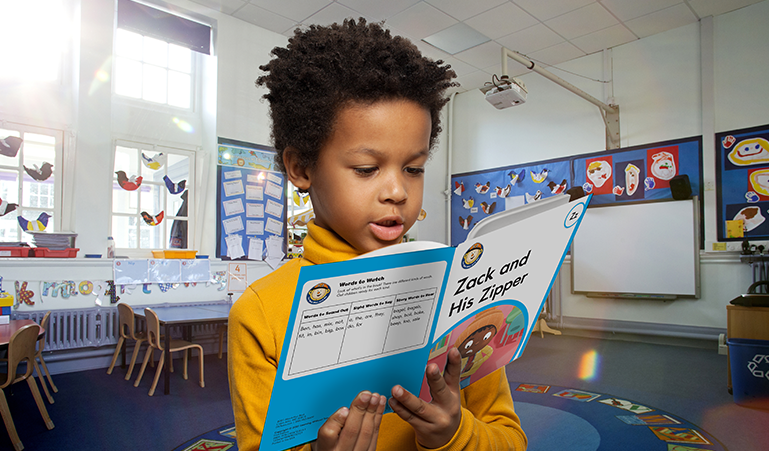Using grade-level texts to teach reading is our best shot at accelerating literacy. Yet many teachers were trained to use below-grade-level texts to instruct students who struggle. Everywhere, teachers are asking: What does a whole-class lesson look like with a grade-level text? How can I possibly get all my students through it? In this blog, I share the practical steps, but first, let’s consider the problems with the status quo.
Why Grouping Has Failed Our Kids
We’ve known for a very long time that the whole-grouping scheme within classrooms has been discriminatory to the bottom group. The better readers are taught with grade-level texts. They benefit from those books' content and their academic-vocabulary-rich discussions. These students gain a sense of themselves as capable learners. Win-win, right?
By contrast, the low readers get siloed in small groups with below-level texts, forever locked in a K–12 system that has put them on a conveyor belt to being forever behind. If a child starts the year two years below grade level and successfully makes a year’s progress for a year’s instruction, they are still two years behind at the end of the year—and without exposure to the grade-level content. Lose-lose, right?
We’ve shut such children out of knowledge, skills, and self-concept of capability. We see children who are graduating from our high schools who are reading at levels that frankly won't allow them to enlist in the military, obtain a paying job they could live on, or succeed with the kinds of textbooks that colleges use in their freshman year.
The Surprising Truth About “Frustration-Level” Texts
Educators have claimed since the 1940s that a text is appropriate for instruction if students can read it with no more than five oral reading errors per hundred words and with 75–89% comprehension. Any harder than that, and it is assumed the text will frustrate students. Trying to avoid that frustration-level text placement, we place students in texts that provide little learning opportunity. Research in the last several years has shown that kids learn just as well, or they learn better when taught with these tougher texts. (Note: This isn’t true for early readers. In grades K–2, they need easier texts as they learn to decode.)
Instead of protecting students from reading texts that they can’t yet read well, we should teach teachers how to deal with challenging texts and how to help kids deal with them.
Planning the Reading Lesson
Placing students in grade-level texts will require some adjustments to how we do business. For example, we need to teach the texts, not particular skills. Trust me, the skill work will be there—it just should be in response to the text rather than the point of the lesson. Think: I am going to help students read this text with success. Not: I’m going to teach the main idea.
Don’t select a text for its readability, but know its readability and how well your students can read. I want to know how hard a book will be for my students. Let’s say I’m a third-grade teacher working with a third-grade textbook. In the past, I would try to identify a student’s reading level to figure out which book I should switch them to. Now, I still want that information, but I just want to find out how much support that student might need.
Ask yourself—what is going to trip them up? The textbook publisher may provide skills in focus, key vocabulary, “yada, yada, yada,” and this information can be helpful. But it’s better to focus on the text itself, feel confident that it’s well-written and engaging enough, and then consider what might potentially confuse students or be difficult for them to understand. It’s a whole different mindset. I’m making the text the center of instruction, and like a hound dog, I’m sniffing out what’s going to get in their way.
Plan questions designed to reveal whether your students indeed stumbled on the “tripwires” you identified. This is an energizing shift—instead of a passive interrogation, ala, "Do you know this word? What’s the main idea?" You are going to be posing a more nuanced set of questions tailored to what you think you know of your learners. You might tease out how they handle an overly long sentence, an infographic, dialogue with few speaker tags, paragraphs with oblique transitions, and the list goes on! You’re not always going to get that right. You’re not always going to know. But I promise you, your questions and in-the-moment further scaffolds are going to do more to help your students read than will avoiding these barriers altogether by placing students at the “instructional level.”
Frame your questions to cast a wide net. You want to avoid narrow, “gotcha” questions. For example, you want to pose questions about words that some students might have trouble with that will impede their comprehension. Let’s say the word is reluctant. If they don’t know it, they are not going to know how the character is feeling and why he did what he did on the next page. But instead of asking: "Do you know what the word reluctant means?" I’m going to ask, "Why did this character do that?" If a student doesn’t know, then you say, "Let's go back to that sentence now as a group. Let's read it. Let's take a look at what you didn't understand there, and we'll fix it."
What I’m suggesting here is a very different kind of questioning routine. And notice that built into it is a can-do, collaborative tone and the expectation that they are going to lean in to figure things out. You are not going to do the work for them.
During the Reading Lesson
Okay, so we’re in the thick of action. We are reading the text together, and I’m asking questions to see if my students struggle or fly through moments of challenge. If they trip up, the next thing I want to know is: can they tackle it again and triumph? As I began to show above, you return to the text section together, and even the more capable readers get something out of hearing you support a classmate who didn’t get something.
Show Them How to Deal with It. As Elvis Pressley said, “Only fools rush in.” Don’t hurry to tell the student a word’s meaning or a character’s emotion or whatever—show them how they can figure it out on their own. For example, I might show them:
- How to reread a few sentences silently or aloud to see if that helps them understand
- How to break down a sentence
- How to use context to figure out a word
- I might say, “We're going to do some fluency work, and then we're going to come back to read it for comprehension.”
This is what it means to teach reading. You use all the tools you have at your disposal to help students during a lesson.

What to Do When Kids Give Up
We’ve all been there. You carefully select a text, plan questions, and ask them to read, and three pages in, you discover they’re just lost. They don’t get it at all. When that happens, I know they are starting to give up. I won’t let them. I take them back and say something along the lines of “You know, we've read three pages. You really struggled with that. Why don't we try and just let's just read the first paragraph? I want you to read the first paragraph, and I'm going to ask you some questions.”
If you can cut it down to a piece of text that is small enough that the kids can scale it, it helps you see what's going on. You may discover that the kids are struggling with the words and need to start with fluency work and then move on to comprehension. Or, perhaps, they wear out after a page. If that’s the case, then you know that next time, you will cut it back to a page and work up from there. Build their stamina. Next, a page and a half. Then, two pages. Then three, and so on.
This leads me to close this blog with one last point about teaching with grade-level texts. Like anything worth learning, there is no such thing as an overnight sensation. You will have to teach hard, and students will have to work hard, developing their strengths and stamina day by day. So, by going back with students to that elusive word, that complex sentence, that character’s abstract inner monologue, you are showing them that this text is worth the work, and they are worth every syllable, every moment, of your time.
Watch Dr. Tim Shanahan's full episode of Literacy Matters: Empowered Conversations to get even more insights.
About the Author
| Dr. Timothy Shanahan is a Distinguished Professor Emeritus at the University of Illinois at Chicago. Formerly, he was director of reading for the Chicago Public Schools and President of the International Literacy Association. Dr. Shanahan served on the National Reading Panel. He is a former first-grade teacher, and his website, Shanahan On Literacy, is widely used by teachers. | 
|